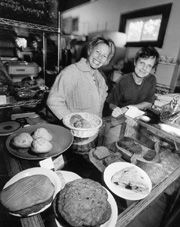DOES ANYONE REMEMBER what we ate for lunch before we had so bloody many Italian sandwiches? Three months ago, there was still one street corner in town without an Italian sandwich vendor; now former Italian restaurateur Pietro Borghesi has taken care of that. His Osteria la Spiga sits at the corner of Broadway and Union like a polished stage set of rustic Italy: tile bar, plank tables, ovens cranking away in the corner. But out of those generic ovens come sandwiches quite unlike the panini you eat every day.
Osteria La Spiga 1401 Broadway, 323-8881 Mon-Sat 11-11 MC,V wine and beer
They’re called piadina: disks of unleavened bread flatter than a pizza crust but chewier than a cracker. An ancient specialty of Borghesi’s native Romagna, a region of Northern Italy on the Adriatic, piadina are topped with meats, cheeses, and vegetables, and are served as sandwiches of the same name. Or they’re fashioned into pockets, like dense pita bread, stuffed with sandwich fixings, and called crescione.
Along with numerous variants of these two specialties, Borghesi and his co-proprietors—his wife, Sabrina Tinsley, and her sister Sashia—serve up a selection of good foils for the triangles of warm piadina: antipasto plates, salads, homemade soups, and fresh pasta. We tried it all.
A platter of mixed cold cuts and cheeses ($5.50) revealed the Borghesi/Tinsley dedication to quality ingredients: The coppa, prosciutto, and pepper salami were of the highest grade, as were the fontina and particularly pecorino Romano cheeses. A basic mixed salad ($3.95) was basic indeed: wild greens, carrots, and cabbage, mixed up and dressed with restraint.
Our waiter, a nice young man whose earnestness made up for his clear deficits in the art of menu exposition, suggested crescione no. 17: a whole-wheat piadina stuffed with four cheeses, cooked prosciutto, and arugula. “Simple” is the word I see scrawled again and again in my notes; “simple” is the impression that stays with me. The four cheeses were melted nicely, the prosciutto was good, the arugula added a zippy counterpoint. But basically this was just a ham-and-cheese sandwich.
The story was different across the table. The Borghesi/Tinsleys produce three or four pasta varieties each night and three or four sauces; diners mix and match. My companion ordered the butternut squash-stuffed ravioli ($8), another Romagnan specialty, in a sage-butter sauce; the homemade pasta was just right, and savory-sweet interplay kept him fascinated all the way to the bottom of the plate.
For dessert we ordered tiramisu ($4)—here called by its regional name of “mascarpone,” after the creamy cheese it’s made of—and found it delectable. We also ordered ciambella, a crumbly yellow cake Romagnans dip either in coffee ($3.50) or in the sweet regional wine called Albana ($3.50). Dryish like biscotti and simply, solidly flavored, the ciambella made a nice understated coda to a nice understated meal.
OSTERIA LA SPIGA’S FOOD seems simple in part because its specialty bread is so spartan. “La spiga” means “the wheat stalk,” and the warm bread comes to the table firm and fragrant and filled with the fullest flavors of the grain. But still, this is crackerbread, and rather more Scandinavian in spirit, shall we say, than Italian. Let leftovers sit a minute too long on your counter and you’ve got something very like cardboard.
Which may be why we never got overly exhilarated about any of the sandwiches we tried here. Piadina no. 4, with prosciutto, mozzarella, and fresh tomatoes ($6.25), was fine: read “ho-hum.” Even the coolest-sounding crescione, filled with delicious pumpkin and potato purée with mozzarella ($5.50), quickly grew tedious.
The caveat, of course, is that we tried only the tip of la Spiga’s iceberg. Perhaps the crescione contadino ($6.95), with sausage and grilled eggplant, would sufficiently ignite the palate; or the crescione rosso alla diavola, ($5.50), with hot salami and cayenne. I’d like to come back and try more of the pasta sauces. Without question, the specialty-of-the-house soup, passatelli, ($4.95/$2.95) was sensational: meat broth enlivened with pellets of crumbly pasta, bread crumbs, nutmeg, and Parmesan. And only one dish—il bruciatino salad ($3.95), in which prosciutto, balsamic vinegar, and bitter greens combined into a vexing clamor—was an outright failure.
Without a doubt, I will go back to Osteria la Spiga. The space is a pleasant place to linger, and I’d like to wander through the wine list. The food is solid, unique, fashioned of quality ingredients, and astonishingly easy on the wallet. That it is also simple doesn’t make it bad; just a place to aim for when the palate is weary.







